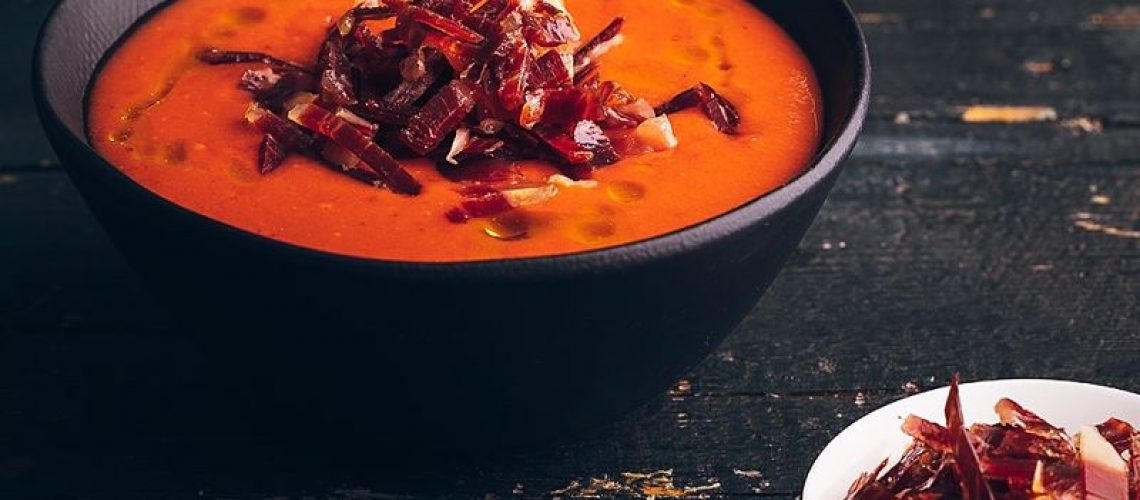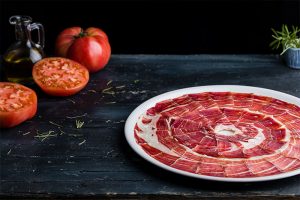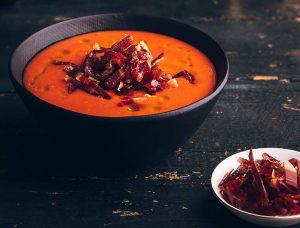Whether you’re in Spain or the United States, summertime means it’s time for all things cold and refreshing. Nobody wants to stand over the stove or turn on the oven at this time of year, and with all the fresh produce available, it’s practically unnecessary. Which is why Spaniards turn to chilled soups, made with fresh, local ingredients to get their fill.
Chilled soups are as much a part of the summertime culture as Jamón 100% Ibérico de Bellota. It’s part of why they make such a fantastic pairing. Learn more about Spain’s love of chilled soups, a few varieties, and even a foolproof recipe for one of our preferred styles to perfectly accompany your jamón.
Original Chilled Spanish Soups
Cold soups are an important part of the rich culinary history of Spain. Originally, these chilled soups were made by hand in a large mortar and pestle, called a lebrilla. The original style of these soups, or gachas, dates back thousands of years. Cooks would mash up a little dry bread, extra-virgin olive oil, and garlic, and leave them to chill in a cool area of the home. It was a way to use up dry bread and provide freshness to hungry eaters in those unbearably hot months of the year.
Another similar style evolved during the Moorish period of Spain, where cooks added almonds into the mix. This is what’s known as ajo blanco, or “white garlic,” and is still eaten throughout the country, particularly in the southern coastal city of Málaga. It’s a creamy white soup made with blanched almonds, garlic, bread, extra-virgin olive oil, and vinegar, and is commonly served with grapes for a sweet burst of flavor.
Spain Loves Gazpacho
You’ve probably heard of gazpacho, or even tasted it on a trip to Spain. It’s that cold tomato soup served in a bowl or poured over ice and sipped from a glass. Gazpacho is one of the most refreshing Spanish foods out there, and it’s essential to summer dining, specifically in warm areas like the south.
Gazpacho shows up in all sorts of styles throughout the country. The classic version with tomato, garlic, white wine vinegar, and extra-virgin olive oil is the most common. Depending on the region, restaurant, or family, cooks will add cucumbers, green bell peppers, or even onion. There are also gazpachos blended with bread, some that are served with garnishes like croutons, and other creative offerings made with fruits like watermelon or strawberries.
Salmorejo Cordobés
One of the globally lesser known styles of chilled summer soups is salmorejo Cordobés. Although some people may describe it as a thick gazpacho at first glance, the nuances in the texture and flavor are different enough to set it apart.
Salmorejo, as it’s known today, came about after the arrival of the tomato to Spain from the Americas. It’s made with the same ingredients as that original handmade gacha, but with the addition of juicy tomatoes. You essentially take ripe, summertime tomatoes and blend them with garlic, bread, extra-virgin olive oil, and salt. What you get is a thick and creamy emulsion of Spanish flavor.
Salmorejo comes from the Córdoba region (hence the name salmorejo Cordobés), where wheat and olive oil are still very plentiful. Those who first made the dish took the best ingredients from their area and mixed them into a cooling emulsion that provided sustenance in the fields and towns. People in this region are so proud of their local dish that they painted an official recipe onto a wall in the middle of the city of Córdoba for all to see.
Córdoba is also known for producing some of the best Jamón 100% Ibérico de Bellota in the world. Which is why it’s only natural to serve salmorejo with diced pieces of Jamón Ibérico. Head to any restaurant in the south of Spain and you’re bound to find salmorejo served with small pieces of magnificent Jamón Ibérico cut from those hard-to-reach spots near the bone. In addition to Jamón 100% Iberico de Bellota, you may even try it served with hard-boiled egg. The combination truly rounds out a complete summertime meal.
Like gazpacho, there are tons of creative and modern versions of salmorejo. You can find green salmorejo made with apple, cucumber, and avocado, or even a bright beet salmorejo. But of course, the most common and most celebrated is the classic version.
Salmorejo is a simple dish, but it’s incredibly flavorful, filling, and refreshing. It reflects the true nature of Spanish cooking: using just a few fantastic ingredients to create a delicious meal everyone can enjoy. And with the perfect balance of acidity, sweetness, and salt, it’s an absolutely addicting summertime dish.
Looking for a summery dish to showcase your Jamón 100% Ibérico de Bellota? Check out the recipe below.
Salmorejo Cordobés with Jamón 100% Ibérico de Bellota
Serves: 4
Ingredients
2 ¼ lbs. tomatoes, peeled
1 garlic clove
½ lb. dry, day old bread
⅔ extra-virgin olive oil, plus more for garnish
2 teaspoons salt
Jamón de Bellota 100% Ibérico, diced
Hard-boiled egg, diced
Instructions
- Place peeled tomatoes and garlic clove in a blender, and blend until smooth and there are no lumps.
- Add the bread, olive oil, and salt, and blend until mixture is smooth and creamy.
- Place in the fridge to chill.
- When ready to serve, pour salmorejo into individual bowls and garnish with Jamón 100% Ibérico de Bellota, hard-boiled egg, and a drizzle of extra virgin olive-oil.
How to Serve Salmorejo
Like the recipe states, salmorejo is best served with Jamón Ibérico, hard-boiled egg, and drizzle of extra-virgin olive oil. Spooning up this luscious emulsion of quality ingredients on a hot day is definitely where salmorejo shines. But it’s not the only way to eat the chilled soup.
Salmorejo can also be used as sauce for meats and veggies, or spread onto a crispy baguette. In some towns in southern Spain, you’ll find people soaking it into their morning toast with a café con leche. In restaurants, you’ll see it sitting under a piece of roasted or preserved fish, or spooned over sautéed vegetables.
Whichever way you choose to eat salmorejo, or any of Spain’s delightful chilled soups, it’s always made better by Jamón 100% Ibérico de Bellota. Delicately lay thin slices over grilled asparagus on a bed of salmorejo, accompany grilled chicken with jamón and a salmorejo sauce, or brighten up a Jamón Ibérico sandwich with a little cooling salmorejo. Salmorejo and Jamón 100% Ibérico de Bellota are the perfect summertime combination. Transport yourself to southern Spain and get a taste of the best the Spanish land has to offer.






